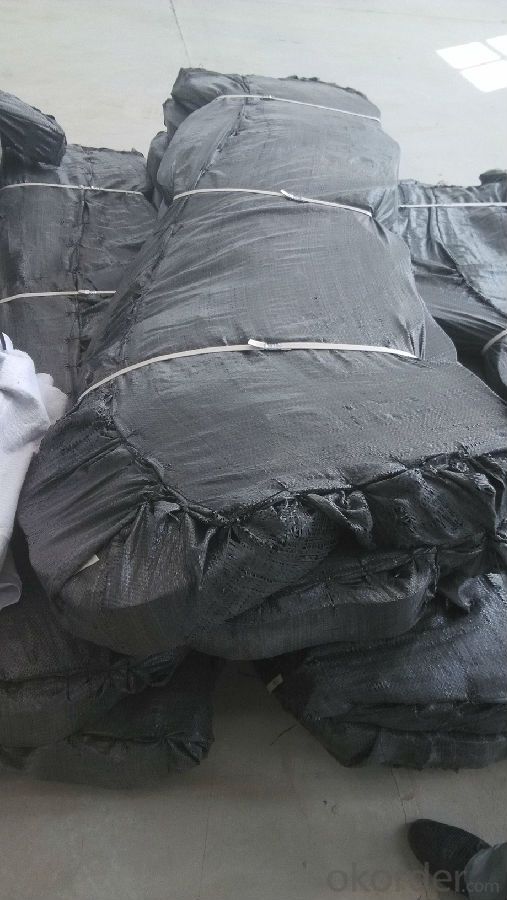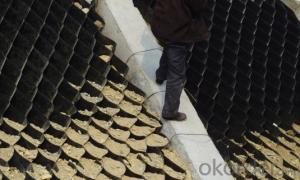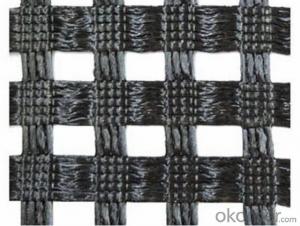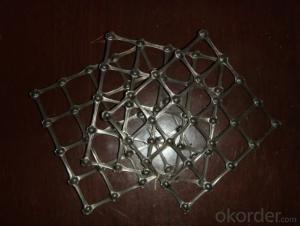Steel Reinforced Geocell for Reforcement treatment for soft soil foundation
- Loading Port:
- Tianjin
- Payment Terms:
- TT OR LC
- Min Order Qty:
- 1000 m²
- Supply Capability:
- 1900000 m²/month
OKorder Service Pledge
OKorder Financial Service
You Might Also Like
The description of Steel Reinforced Geocell for Reforcement treatment for soft soil foundation and steep slope protection highway airport desert mountain and swamp land
Steel reinforced geocell is made by double braided plug-in plug connecting high strength thermoplastic sheets, tensile strength of sheets and tensile strength of welding points is consistent, formed a integrated geocell, fully applied the stereoscopic reinforced effect of geocell.
Specification of Steel Reinforced Geocell for Reforcement treatment for soft soil foundation and steep slope protection highway airport desert mountain and swamp land
TG LG5. TG LG8. TG LGIO. TG LG15. TGLG20 ( cm )


Property of Steel Reinforced Geocell for Reforcement treatment for soft soil foundation and steep slope protection highway airport desert mountain and swamp land
I. Retractile, foldable when transportation, pulled to network when construction, fill in the soil, gravel, concrete etc. Loose materials, form one structu re with strong lateral limitations and high stiffness
2. Material is light, abrasion resistance, chemical properties stable, resist photooxidation aging, acid and alkali resistant, suitable for different soil and soil conditions, such as desert
3. Good lateral restrict and prevent slippery, prevent deformation, effectively enhance the bearing capacity of subgrade and dispersed loads function
4. The geocell height and welding dista nce etc. Geometric dimensions are all changeable in order to meet the requirements of different projects
5. Capable and easily be expanded or contracted, small size for transportation, easy for connect and construction speed is fast
Application of Steel Reinforced Geocell for Reforcement treatment for soft soil foundation and steep slope protection highway airport desert mountain and swamp land
Reinforcement treatment for soft soil foundation and steep slope protection, used in highway,
Railway, airport, wharf, especially in airslaked mountain, desert and swamp land etc.
Area |
|
Hydraulic | Lagooning and Water Treatment, Ornamental Ponds, Golf Courses Aquaculture and Desalination Water LagoonsTanks, Reservoirs, Liquid WasteFloating Cover SolutionsDrainage and FiltrationShading Cover Solutions |
Environment | Tailing ponds, Leach mining,Landfills,Landfill Capping,Protection against corrosion,Vertical Barriers |
Civil Works | Erosion Control, Secondary Containment, Tunnels,Linear and Surface Works,Consolidation of Margins,Soil Reinforcement,Soil Separation. |
Building | Parkings,Roofing,Soundproofing building |
- Q:Are geogrids effective in stabilizing embankments for pipeline crossings?
- Yes, geogrids are effective in stabilizing embankments for pipeline crossings. Geogrids provide reinforcement and increase the stability of the soil, preventing erosion and potential slope failures. They distribute loads and reduce settlement, ensuring the integrity of the embankment and protecting the pipeline.
- Q:0.3m drainage geogrid
- If you have any questions about the geogrid do not understand can ask the manufacturers and so on
- Q:How to fill in the geogrid evaluation form
- Detection method and frequency in accordance with the requirements, the other reference to your command requirements!
- Q:How do geogrids help in reducing soil compaction?
- Geogrids help in reducing soil compaction by distributing the load from traffic or construction equipment more evenly across the soil surface. This helps to minimize the concentration of pressure on specific areas, preventing excessive compaction and allowing for better soil structure and drainage.
- Q:What are the design considerations for geogrids in mechanically stabilized earth walls?
- Some of the key design considerations for geogrids in mechanically stabilized earth (MSE) walls include selecting the appropriate geogrid material and strength, determining the required geogrid spacing and length, considering the connection and anchorage details, assessing the interface friction between the geogrid and the soil, and evaluating the long-term durability and performance of the geogrids in the specific environmental conditions. Additionally, proper installation practices and quality control measures should be implemented to ensure the geogrids are correctly positioned and tensioned within the MSE wall system.
- Q:Glass fiber grille modified asphalt, polyester grille coated PVC.
- Bidirectional welding plastic top net, high strength spiral rib steel wire grid model, integrated 3D Geomat, high strength geogrid, geocell, engineering fiber, geotextile composite geomembrane, whichincludesimportedwetthinfeltproductionline engineering materials used in underground coal mine
- Q:Refers to the size of the geogrid mesh holeSpecific attention is not clear, the banner of Chang Chang official CafeThere's something you're looking forGrille generally by the vertical and horizontal staggered from the simple meaning of space can also be understood that the size of the lattice gap.
- Refers to the size of the geogrid mesh holeSpecific attention is not clear, the banner of Chang Chang official CafeThere's something you're looking forGrille generally by the vertical and horizontal staggered from the simple meaning of space can also be understood that the size of the lattice gap.
- Q:What are the potential drawbacks of using geogrids?
- One potential drawback of using geogrids is the high cost associated with their installation and maintenance. Geogrids are typically made from synthetic materials, which can be expensive to produce and purchase. Additionally, the installation process often requires specialized equipment and skilled labor, further increasing the overall cost. Another drawback is the limited effectiveness of geogrids in certain soil conditions. Geogrids are typically designed to enhance soil stability and reinforce weak or unstable soils. However, in cohesive soils or highly organic soils, geogrids may not provide the desired level of reinforcement. In such cases, alternative solutions or additional measures might be necessary. Moreover, geogrids require proper design and careful installation to ensure their effectiveness. If not installed correctly, geogrids may not perform as intended and could potentially fail. This could result in the need for costly repairs or replacements. Lastly, geogrids may have environmental concerns associated with their production and disposal. Synthetic materials used in geogrids are not biodegradable and may contribute to pollution if not properly managed. Additionally, the manufacturing process of these materials often involves the use of fossil fuels and can generate greenhouse gas emissions. Overall, while geogrids offer numerous benefits in terms of soil reinforcement and stabilization, it is important to consider their drawbacks, including high cost, limited effectiveness in certain soil conditions, installation requirements, and potential environmental impacts.
- Q:What are the factors that affect the installation cost of geogrids?
- The factors that affect the installation cost of geogrids include the type and quality of the geogrid material, the size and complexity of the project area, the required preparation of the site, the method of installation (such as manual or mechanical), the labor and equipment costs, and any additional materials or accessories needed for proper installation.
- Q:What are the design considerations for geogrid installation?
- Some of the key design considerations for geogrid installation include selecting the appropriate type and strength of geogrid material based on the specific application and soil conditions, determining the correct spacing and orientation of the geogrid layers, ensuring proper soil compaction and preparation before installation, and considering factors such as slope stability, load bearing capacity, and drainage requirements. Additionally, proper anchoring and connection techniques, as well as proper quality control and monitoring during installation, are essential for a successful geogrid installation.
1. Manufacturer Overview |
|
|---|---|
| Location | |
| Year Established | |
| Annual Output Value | |
| Main Markets | |
| Company Certifications | |
2. Manufacturer Certificates |
|
|---|---|
| a) Certification Name | |
| Range | |
| Reference | |
| Validity Period | |
3. Manufacturer Capability |
|
|---|---|
| a)Trade Capacity | |
| Nearest Port | |
| Export Percentage | |
| No.of Employees in Trade Department | |
| Language Spoken: | |
| b)Factory Information | |
| Factory Size: | |
| No. of Production Lines | |
| Contract Manufacturing | |
| Product Price Range | |
Send your message to us
Steel Reinforced Geocell for Reforcement treatment for soft soil foundation
- Loading Port:
- Tianjin
- Payment Terms:
- TT OR LC
- Min Order Qty:
- 1000 m²
- Supply Capability:
- 1900000 m²/month
OKorder Service Pledge
OKorder Financial Service
Similar products
New products
Hot products
Related keywords






























